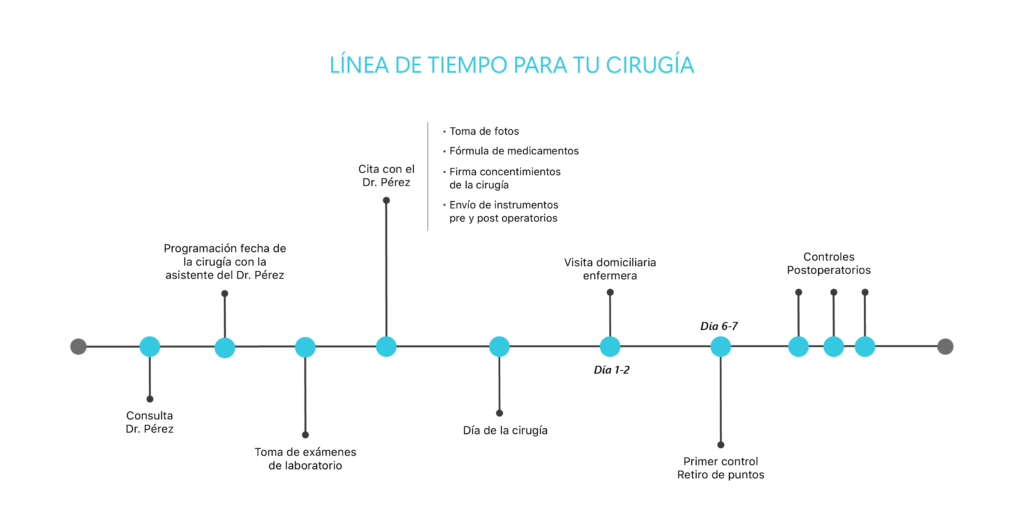PRE AND POSTOPERATIVE GUIDELINES
PRE AND POSTOPERATIVE GUIDELINES
My commitment is total and sincere in achieving the goals we have set prior to your surgery. The harmony and naturalness of your results will be a reflection of our motto: everyone will notice, but no one will know. Lastly, you can rest assured that both I and my entire team will be ready to provide you with all our support and advice throughout your journey.
GENERAL CONSIDERATIONS
Proper preparation is essential to achieve excellent results and optimal recovery after a surgical procedure. Having a clear understanding of how to prepare and what to expect during the postoperative phase focuses your mind on each stage of your recovery. It’s important to highlight that each patient’s swelling and postoperative healing process are unique and individual, so our recommendation is not to compare one person’s recovery with another’s.
Having performed thousands of surgical procedures for nearly 30 years, I can assure you that regardless of the type of procedure, the vast majority of my patients can enjoy a smooth and uncomplicated recovery. This is primarily due to the fact that I practice highly predictable minimally invasive surgical techniques, always assisted by cutting-edge technology.
The early phase usually spans the first week and a half after surgery, during which the highest degree of swelling typically occurs in the first 2 to 3 days. Then, there is a rapid process of deflating, which generally lasts until the second week. At this point, most patients look good enough to return to their social or work activities, but it’s important to consider that their recovery process is not yet complete, and they will gradually observe changes and improvement in their appearance.
The late phase can extend beyond the first 6 months, during which the scarring becomes almost imperceptible, and the appearance becomes more and more natural. The video titled “The Roller Coaster of Recovery,” which you will find below, provides a clear and realistic overview of this entire process.

PREOPERATIVE INSTRUCTIONS

PRE AND POSTOPERATIVE TIMELINE
WHAT TO EXPECT AFTER SURGERY
The following manifestations are considered normal when they appear:
Swelling and bruising
When these occur mildly or moderately, they can be considered normal. They may appear asymmetrically and with varying intensity. Bruising will gradually resolve, changing color during its evolution, typically turning green and yellow before disappearing completely.
Pain (mild to moderate)
Pain may occur depending on each patient and the surgical procedure performed. If the pain becomes intense and increases progressively, it should be immediately reported to Dr. Pérez's team.
Bleeding
The presence of minor bleeding through surgical incisions or from a drainage left during surgery is considered normal. However, if bleeding becomes abundant and is accompanied by pain, it should be reported to Dr. Pérez's team.
Loss of sensitivity (numbness)
This generally occurs in areas surrounding the surgical incisions and is temporary, returning to normal within a few months.
Nausea and vomiting
These are not uncommon and are generally side effects of anesthesia medications. Some patients may have a marked susceptibility to these medications, so it is recommended to notify the surgical team before the procedure to take appropriate measures.
Redness or itching at surgical incisions
Incisions usually undergo an evolutionary process, changing from an initial pink color to becoming practically imperceptible. We recommend the use of a topical antibiotic and anti-inflammatory ointment to be applied to the incisions during the first week and a half. Subsequently, scar healing cream will be applied for several months.
POSTOPERATIVE INSTRUCTIONS
These videos have been carefully prepared so that each of our patients can watch them before undergoing their surgical procedure. Our team will be available to address any questions or concerns that may arise.
POSTOPERATIVE CARE FOR HAMMOCK FACELIFT

POSTOPERATIVE CARE FOR BLEPHAROPLASTY

POSTOPERATIVE CARE FOR RHINOPLASTY

POSTOPERATIVE CARE FOR ABDOMINOPLASTY

- Proper skincare is essential and can be maintained through the continuous use of topical products such as Retinoic Acid, Vitamin C, and high-quality sunscreen.
- Nowadays, there is a wide variety of cosmetic treatments that are effective in stimulating collagen production in skin cells. Among the most commonly performed are Microneedling with Platelet-Rich Plasma, facial peels, and various options for laser treatments.
- Based on his extensive experience, Dr. Pérez recommends undergoing a facial Lipofilling procedure with stem cells every 2 to 3 years, as this has been proven to be an excellent collagen-inducing technique in soft tissues and the skin. This helps maintain youthful and smooth skin while also preventing facial volume loss, which typically occurs during the aging process.
- The application of Botox two to three times a year significantly reduces the appearance of fine expression lines in different areas of the face.
- Maintaining a balanced diet appropriate to each patient’s nutritional requirements is crucial.
- Engaging in physical exercise at least four times a week has shown enormous benefits for both physical and mental health.

